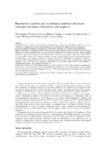Mostrar o rexistro simple do ítem
Hypotension, acidosis and vasodilation syndrome after heart transplant: incidence, risk factors, and prognosis
| dc.contributor.author | Paniagua-Martín, María J. | |
| dc.contributor.author | Crespo-Leiro, María Generosa | |
| dc.contributor.author | Muñiz, Javier | |
| dc.contributor.author | Vázquez, E. | |
| dc.contributor.author | Tabuyo, T. | |
| dc.contributor.author | Castro-Orjales, M. | |
| dc.contributor.author | Fojón, S. | |
| dc.contributor.author | López, J.M. | |
| dc.contributor.author | Garrido, Iris P. | |
| dc.contributor.author | Juffé-Stein, Alberto | |
| dc.contributor.author | Castro-Beiras, Alfonso | |
| dc.date.accessioned | 2015-10-21T11:20:07Z | |
| dc.date.available | 2015-10-21T11:20:07Z | |
| dc.date.issued | 2003-08-30 | |
| dc.identifier.citation | Paniagua MJ, Crespo-Leiro MG, Muñiz J, Vázquez E, Tabuyo T, Castro-Orjales M, et al. Hypotension, acidosis and vasodilation syndrome after heart transplant: incidence, risk factors, and prognosis. Transplant Proc. 2003;35(5):1957-1958 | es_ES |
| dc.identifier.uri | http://hdl.handle.net/2183/15400 | |
| dc.description.abstract | [Abstract] Background. HAV syndrome, the combination of hypotension, acidosis and vasodilation (HAV), is a serious postoperative complication after heart transplantation (HT). Its etiology and prognosis are poorly understood. Aim. To determine the incidence and prognosis of post-HT HAV syndrome and examine possible risk factors. Methods. Retrospective examination of the records of 85 consecutive patients who underwent HT between December 1999 and June 2002 sought the HAV criteria: systolic BP <85 mm Hg plus HCO3 <19 mEq/l whole excluding cardiogenic, hypovolemic and septic shock. Donor variables included sex, age, weight, height, cause of death, time in ICU, and ischemic time; while recipient variables, sex, age, weight, height, etiology of cardiopathy, previous cardiopulmonary bypass surgery, preoperative amiodarone, β-blockers, catecholamines, mechanical ventilation or intra aortic balloon pump (IABP), RVP, time on waiting list, pump time, reoperations, polytransfusion, preoperative creatinine, GOT, GPT and GGT, induction with OKT3 or anti-CD25, bypass-to-HAV time, duration of catecholamine treatment, and 1 month survival after HT. Results. The 11 HAV cases (13%) appeared between 1 and 72 h after HT (75% in the first hour). Catecholamines were used for 1 to 6 days; control was achieved within 48 h in 58% of cases. Two HAV patients (18%) died within the first month versus six non-HAV patients (8.1%) (P = .275). Only polytransfusion showed more than a borderline value to predict HAV syndrome. Conclusions. HAV syndrome has an incidence of 13% and a mortality of 18% within 1 month post-HT. The only likely risk factor is polytransfusion. | es_ES |
| dc.language.iso | eng | es_ES |
| dc.publisher | Elsevier | es_ES |
| dc.relation.uri | http://dx.doi.org/10.1016/S0041-1345(03)00730-9 | es_ES |
| dc.rights | Creative Commons Licence | es_ES |
| dc.rights | Reconocimiento-NoComercial-SinObraDerivada 4.0 Internacional | |
| dc.rights.uri | http://creativecommons.org/licenses/by-nc-nd/4.0/ | |
| dc.title | Hypotension, acidosis and vasodilation syndrome after heart transplant: incidence, risk factors, and prognosis | es_ES |
| dc.type | info:eu-repo/semantics/article | es_ES |
| dc.rights.access | info:eu-repo/semantics/openAccess | es_ES |
Ficheiros no ítem
Este ítem aparece na(s) seguinte(s) colección(s)
-
GI- GRINCAR - Artigos [216]






